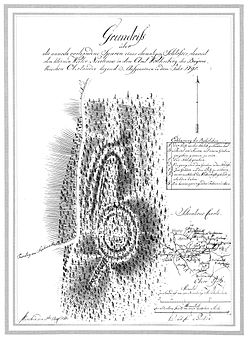Burgstall Schlosshügel
| Burgstall Schlosshügel | |
|---|---|
| Gurtstein? | |
| Weidenberg-Sophienthal-"Schlosshügel" | |

1791 plan of the castle site by Stierlein
|
|
| Coordinates | 49°57′13″N 11°46′16″E / 49.95348°N 11.77120°ECoordinates: 49°57′13″N 11°46′16″E / 49.95348°N 11.77120°E |
| Type | hill castle, spur castle, motte |
| Code | DE-BY |
| Height | 699 m above sea level (NN) |
| Site information | |
| Condition | burgstall with recognisable ditches and ramparts |
| Site history | |
| Built | presumably during the 11th century |
| Materials | wooden palisades, log construction |
| Garrison information | |
| Occupants | unknown |
The Burgstall of Schlosshügel near Weidenberg is a lost hill castle or circular rampart site of the type known as a motte from the Early Middle Ages. It lies on the southern perimeter of the Fichtel Mountains at a height of 699 metres above sea level (NN) above the village of Sophienthal, which is part of the market borough of Weidenberg in the Upper Franconia county of Bayreuth in Bavaria. The burgstall or lost castle site was partly investigated by means of an archaeological test excavation and was also mapped several times in the past.
No records of the castle site have been found and nor is its name known. It could be the fortress listed as "Gurtstein mitsamt dem Walde" ("Gurtstein including the woods") mentioned from 1412 in deeds of enfeoffment. What is known is that a tower was built on strategically favourable high ground in order to observe the surrounding area with line-of-sight visibility to other signal or beacon hills in the Weidenberg valley, in the upper Steinach valley and in the northern part of the Upper Palatinate (with its large castle on the Rauher Kulm). Over the course of time this motte tower was expanded to form an enclosure with a circular rampart.
The local historian, Joachim Kröll, wrote about it thus:
The remains are especially easy to make out; they show how originally a tower motte stood by itself on the hill and that other parts of a fortification were built by it and protected by ditches and ramparts. The site is dated to the Romanesque period, which in comparison with other tower mottes would be no later than the early 11th century.
...
Wikipedia

